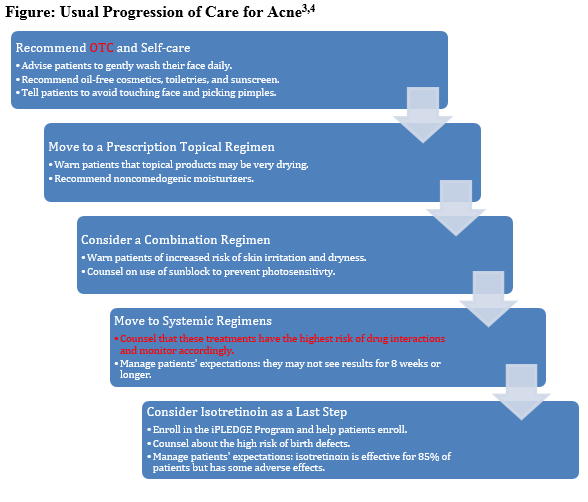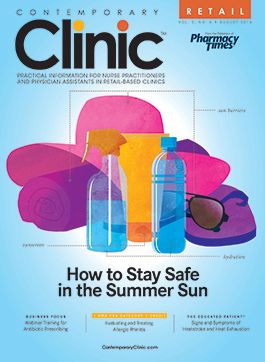Avoiding Interactions with Acne Medications
Acne is the most common skin condition in the United States, affecting up to 50 million Americans annually.
Acne is the most common skin condition in the United States, affecting up to 50 million Americans annually.1Practitioners usually see patients with acne who are in their mid-teens to mid-twenties. This is a time when patients have a growing sense of autonomy and independence, yet they may have little experience with medication. These patients want relief from acne, but they need careful, age-appropriate guidance.2
Clinical Guidelines
The American Academy of Dermatology (AAD) just updated guidelines describing best practices for acne management.3Acne is classified into 3 categories: mild, moderate, and severe. Treatment normally progresses from OTC products, to topical products, to systemic treatments, to combination treatments, and ultimately to isotretinoin.Figure3,4describes the usual progression of care based on the AAD guidelines.

Prescribing Considerations
Anti-acne products have limited drug-drug interactions. Many interactions are hypothetical or uncommon if the medication is formulated as a topical ointment. However, some interactions worth noting are listed inTable4,5.
TABLE: ACNE DRUG-DRUG INTERACTIONS4,5
Medication
Possible Interactions
Salicylic Acid
Topical retinoids
· Increased dryness, erythema, and irritation
Topical Erythromycin
Alcohol-containing cosmetics; medicated soaps or abrasive, peeling, or desquamating agents; clindamycin, sulfur, tretinoin
· Increased dryness, erythema, and irritation
Topical Clindamycin
Neuromuscular blocking agents
· May enhance the action of other neuromuscular blocking agents
Topical Retinoids
Keratolytic agents, photosensitizing agents
· Increased dryness, erythema, and irritation
Systemic Tetracyclines
Antacids (aluminum-, calcium-, magnesium-containing)
· May decrease absorption of antibiotics, decreasing effectiveness
Oral anticoagulants
· May increase bleed risk
Atovaquone and penicillins
· May decrease efficacy of these medications
Systemic Erythromycin
Antiarrhythmic agents
· May prolong QTC interval
Oral anticoagulants
· May increase bleed risk
Azole antifungals, calcium-channel blocking agents, antiseizure medications
· These medications may increase levels of erythromycin
HMG-CoA reductase inhibitors, ergots, sildenafil, benzodiazepines
· Erythromycin may increase levels of these medications
OCP
Many antibiotics, antifungals, seizure medications, antivirals, chemotherapy, steroids, antidepressant medications, pain medications
· May decrease effectiveness of OCPs
Spironolactone
Tacrolimus, cyclosporine, ACEIs, ARBs, potassium, sulfamethoxazole/trimethoprim, eplerenone, NSAIDs
· Potassium serum changes
Isotretinoin
Tetracyclines, vitamin A, methotrexate, contraceptives, alcohol
· Increased dryness, erythema, and irritation
ACEIs= angiotensin-converting-enzyme inhibitors; ARBs= angiotensin II receptor blockers; NSAIDs= nonsteroidal anti-inflammatory drugs, OCP= oral contraceptive products
Just as patients who take diphenhydramine for allergies expect a certain amount of drowsiness, patients who use acne products should expect erythema, dryness, irritation, and photosensitivity.3,6Many (but not all) of these adverse effects diminish as the patient’s skin becomes accustomed to the product’s effects. Consequently, patients should be advised that it is best to start with low concentrations and gradually work up to a full regimen.
Topical retinoids are known to make the skin especially sensitive to light, so advise patients to apply these medications only in the evening.7Benzoyl peroxide has a potent bleaching effect, and patients (and especially adolescents’ mothers) appreciate knowing that it can bleach their linens, clothes, and even hair.8Dry skin is a common adverse effect of most acne treatments, but not necessarily a reason to discontinue a product. Adding on a noncomedogenic moisturizer can improve adherence and mitigate dryness, making treatment more tolerable.9
Some interactions are actually magnified adverse effects. If our hypothetical diphenhydramine patients go on a cruise and bring along meclizine for motion sickness, for instance, that medication’s propensity to cause drowsiness in combination with diphenhydramine’s tendency to do the same can be additive.3Similarly, using multiple topical treatments can amplify adverse effects and irritate skin much more than either product alone would. For this reason, when adding a topical agent, advise patients to use it every other day or only once a day until they know how it affects them and until their skin adjusts. If irritation is severe, advise patients to discontinue the product and schedule a dermatology appointment.6
In rare cases, individuals who have used a nonprescription acne product may develop serious hypersensitivity reactions that include hives, throat tightness, and wheezing. The FDA received 131 such reports between 1969 and 2013, and all products connected to those reports contained benzoyl peroxide or salicylic acid.10,11
Systemic Treatment
Antibiotics should not be the sole drug employed for acne; instead, they should be used in conjunction with benzoyl peroxide or another topical treatment. Antibiotic resistance is a growing problem, and researchers have found that young patients treated with antibiotics for acne are more likely to carry drug-resistantPropionibacterium acnes. To prevent resistance, patients should use complementary agents, such as benzoyl peroxide.12
Isotretinoin is the most potent form of acne treatment on the market. It is the only medication approved for severe cystic acne. A single 4- to 6-month course of treatment has been shown to be effective for 85% of patients. It is also associated with improvement in depression and anxiety symptoms and improved quality of life in patients with severe acne.4This product is contraindicated in pregnant females.
Women of childbearing age taking isotretinoin must follow strict rules to prevent pregnancy, as risk of birth defects is high, even with a short exposure. All providers and patients must enroll in the iPLEDGE program, a computer-based risk management program designed to eliminate fetal exposure to isotretinoin through a restricted distribution program approved by the FDA. The program requires patients to use 2 forms of contraception and undergo periodic pregnancy testing. Providers also must educate patients every month when they prescribe this product.13
References
1. American Academy of Dermatology. Acne. aad.org/media/stats/conditions. Accessed April 22, 2016.
2. Karpa KD, Felix TM, Lewis PR. Adverse effects of common drugs: Children and adolescents.FP Essent.2015;436:17-22.
3. American Academy of Dermatology. Guidelines of care for the management of acne vulgaris. aad.org/File%20Library/Main%20navigation/Practice%20tools/Quality%20care%20and%20guidelines/Acne-Guideline-2016.pdf. Accessed April 22, 2016.
4. American Academy of Dermatology. Prescribing information for acne treatments. aad.org/practice-tools/quality-care/clinical-guidelines/acne/prescribing-information-for-acne-treatments. Accessed April 22, 2016.
5. American Academy of Dermatology. Learning module: Acne and rosacea. aad.org/education/basic-derm-curriculum/suggested-order-of-modules/acne-and-rosacea. Accessed April 22, 2016.
6. American Academy of Family Practitioners. Diagnosis and treatment of acne. aafp.org/afp/2012/1015/p734.html. Accessed April 22, 2016.
7. Valeant Pharmaceuticals. Retin-A Product Insert. valeant.com/Portals/25/Pdf/PI/Retin-A-Retin-A-Micro-PI.pdf. Accessed April 22, 2016.
8. Valeant Pharmaceuticals. Acanya Product Insert. acanyagel.com/AcanyaPumpPI_FINAL.pdf. Accessed April 22, 2016.
9. Munehiro A, Murakami Y, Shirahige Y, et al. Combination effect of moisturizers in the topical treatment of acne vulgaris. J Dermatology Treatment. 2012;23(3):172-176. doi: 10.3109/09546634.2010.551109.
10. FDA. Topical acne products can cause dangerous side effects. FDA website. fda.gov/ForConsumers/ConsumerUpdates/ucm402441.htm#Types%20of Reactions. Published June 25, 2014. Accessed April 22, 2016.
11. American Academy of Dermatology. Acne products: How to avoid allergic reaction. aad.org/public/diseases/acne-and-rosacea/acne-products-how-to-avoid-allergic-reaction. Accessed April 22, 2016.
12. Dréno B, Lambert J, Bettoli V. Are retinoid/antibiotic fixed-dose combination
acne treatments associated with antibiotic resistance?Eur J Dermatol. 2016;26(1):90-91. doi: 10.1684/ejd.2015.2654.
13. iPLEDGE Program. About iPLEDGE. ipledgeprogram.com. Accessed April 22, 2016.

